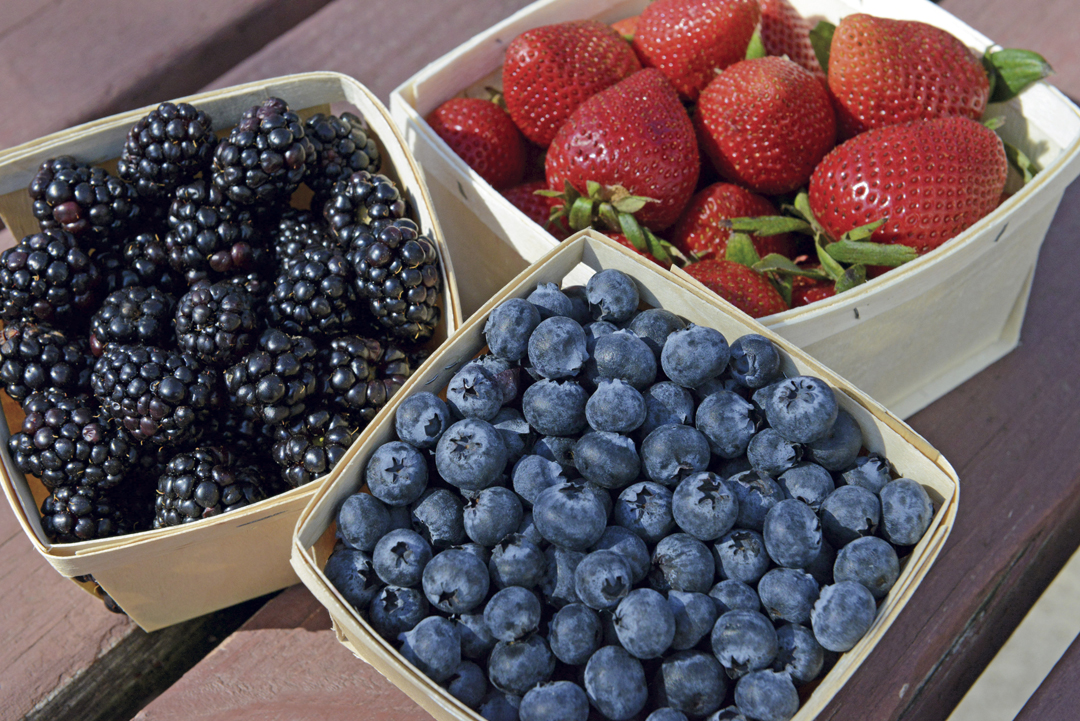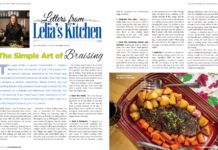To show you how old I am, I remember when fresh berries were markers of the seasons. Strawberries appeared only at the height of spring, in late May or early June, and heralded the coming of summer. Blueberries and blackberries were high summer fruit, and when they were gone, we knew fall was fast approaching.
Today, of course, fresh berries are available at the supermarket year-round, grown, when winter is upon us, in warmer climes. (Mexico is a prime producer of blackberries; California has industrialized the production of strawberries.)
To transport strawberries from California to, say, Louisville, varieties that can stand up to bulk packing and trucking long distances trade off flavor for size and resistance to human touch. Chalky-white cores in golf ball-sized strawberries rather than juicy, red-throughout, thumb-sized fruit, and a tooth-resistance that approaches a crunch instead of a chin-dribbling juiciness, indicate berries that have traveled further than you have in the last two weeks.
Berries are so seductive in looks and in taste that we put up with less than optimal commercial fruits. Therefore, when local berries are in season, we should jump to buy them and be happy to pay local growers premium prices for really fresh fruit that harks back to the time, not all that long ago, when food was seasonal, and all the more precious for that.
To botanists suffering from an obsession with precision nomenclature, the term “berry” is both limiting and remarkably inclusive. To such, a berry is a “many-seeded pulp fruit, the seeds of which are, when mature, scattered throughout the pulp.” While such a definition does include cranberries, gooseberries and grapes, it does not include blackberries or raspberries, which are a sub-category of “drupes,” or strawberries, which are even termed a “false fruit,” because the seeds appear on the fruit’s exterior.
To make matters worse, of course, the first definition of berry, when applied most precisely, includes bananas, cucumbers and papayas, as well as citrus. And, as a reader or two of my newspaper food stories delighted in reminding me whenever I used to refer to tomatoes as vegetables, they are, technically, berries as well.
But our concerns here today are with “any small globular or ovate juicy fruit not having a stone,” which the Oxford English Dictionary usefully reminds us is the commonly accepted notion of what a berry is to those of us who await their arrival in local markets. I hope this year’s strawberry and blueberry crops are as robust as they were last year. When local fruit starts appearing at farmers markets, here are some things I like to do with them.
SUMMER SALAD WITH BERRIES
Strawberries give this salad color and tang before the tomato season kicks in.
½ pound mixed spring greens, baby lettuces or mesclun
2 cups strawberries, in season
Toasted pecans (recipe below)
2 tablespoons grated Parmesan cheese
Toasted sesame-poppy dressing (recipe below)
Arrange mixed greens on four individual plates. Place berries on top of greens. Sprinkle each serving with 2-3 tablespoons toasted pecans, and dress with sesame-poppy dressing. Serves 4.
TOASTED PECANS
½ pound pecans
¼ cup extra virgin olive oil
¼ cup sugar
Chop pecans coarsely, drizzle with olive oil, then sprinkle with sugar. Bake at 325 degrees for 30 minutes, stirring occasionally. Let cool and store covered in refrigerator.
TOASTED SESAME-POPPY DRESSING
You can buy toasted sesame seeds, but if you can’t find them, spread sesame seeds in a thin layer in a small baking pan and toast at 350 degrees for about 20 minutes, or until golden, stirring occasionally.
¾ cup sugar
1 teaspoon dry mustard
1 teaspoon salt
3 tablespoons chopped onions
¼ cup cider vinegar
2 tablespoons balsamic vinegar
½ teaspoon Worcestershire sauce
1 cup Mazola oil
2 tablespoon poppy seeds
¼ cup toasted sesame seeds
In a bowl, mix together the sugar, mustard, salt and chopped onion. Add the vinegar and Worcestershire sauce, and whisk together thoroughly. Whisk in the oil, and when well blended, mix in poppy and sesame seeds. Makes about 1½ cups of dressing.
MELT-IN-YOUR-MOUTH BLUEBERRY CAKE
This is perhaps my favorite cake. I make it every year as soon as the blueberries come in. I found the recipe in Raymond Sokolov’s “Fading Feast” (David R. Godine, 1998).
- 2 eggs, separated
- 1 cup sugar, plus 2 to 3 tablespoons to sprinkle on top
- ½ cup (1 stick) unsalted butter, room temperature
- Pinch of salt
- 1½ cups all-purpose flour, plus ¼ cup
- 1 teaspoon baking powder
- 1/3 cup milk
- 1½ to 2 cups blueberries, washed and picked over
Heat oven to 350 degrees. Beat egg whites until foamy, then beat in 1/4-cup sugar. Continue beating until whites are stiff and glossy. Set aside. Beat butter until light. Beat in remaining cup of sugar and a pinch of salt. Beat in egg yolks one at a time. Blend well. Sift flour into a large bowl. Measure out 1½ cups sifted flour, and resift that with baking powder. Stir about half of flour mixture into butter. Add about half the milk. Blend that well, before repeating with remaining flour and milk.
When batter is well mixed, fold in beaten egg whites, trying not to deflate whites too much. Toss blueberries with about 1/4-cup flour, to help them not drop to the bottom of the batter. Fold berries into batter and scrape batter into a well-greased 8-by-8-inch cake pan. Sprinkle top with 2 to 3 tablespoons sugar.
Bake in middle of oven for about 45 to 55 minutes, until top is golden, cake pulls away slightly from the sides of the pan, and a toothpick tests clean when inserted in the middle. This is a fine snack cake to eat with your fingers or to serve more formally, if you wish. Serves 8.


























